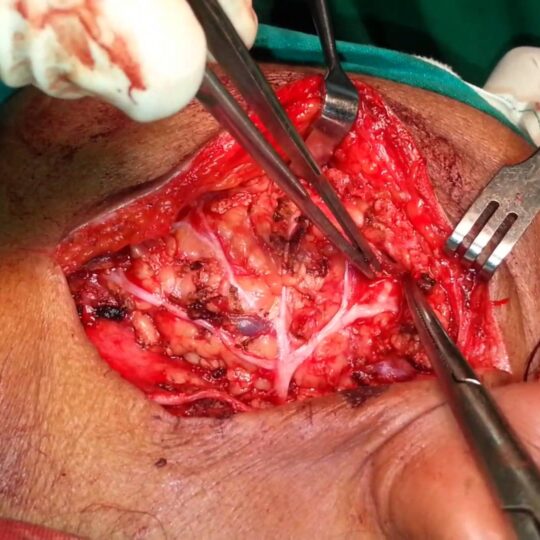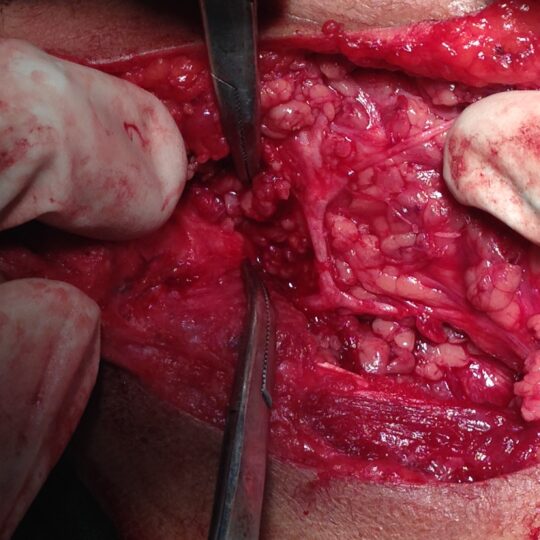Parotid Gland
Salivary gland tumors
Parotid is the largest salivary gland and it is the place where most of the salivary gland tumors arise from. Most of them are non-cancerous. Usually it’s a painless swelling and is evaluated by fine needle aspiration cytology and radiological investigation to know the extent.



What is the parotid and what causes parotid lumps?
The parotid gland makes saliva; you have two parotid glands, one on each side, in front of your ears. Lumps occur in the parotid due to abnormal overgrowth of some part of the salivary glands (a parotid gland tumour). Most tumours are benign, which means that they are not cancerous (malignant) and do not spread to other parts of the body. Rarely, malignant tumours can also affect the parotid. Your doctor will probably collect a needle sample(FNAC) from the lump in order to try to find out what sort of tumour you have.
Why remove the lump?
Although 80% of these lumps are benign in most cases we recommend that they be removed since they generally continue to grow and can become unattractive, and after many years a benign lump can turn malignant. Also the bigger the lump the more difficult it is to remove. Lastly, there is always some concern about the exact cause of the lump until it has been removed.
What is a Parotidectomy operation?
A parotidectomy is the surgical removal of part or all of the parotid gland. The operation is performed under general anaesthetic, which means that you will be asleep throughout.
- An incision (cut) will be made which runs from in front of your ear and down into your neck. This incision heals very well indeed; the incision is nearly the same as the one used in “face lift” surgery, and in time the scar is likely to be minimal.
- At the end of the operation the surgeon will place a drain (plastic tube) through the skin in order to prevent any blood clot collecting under the skin.
- Most patients will require 24 – 48 hours in hospital after the operation before the drain can be removed and they can go home.
Possible complications
Facial weakness:
There is a very important nerve, the facial nerve, which passes right through the parotid gland. This makes the muscles of the face move and if it is damaged during the surgery can lead to a weakness of the face (facial palsy). In most cases the nerve works normally after the surgery. However sometimes (in about 5-10% of cases), where the tumour has been very close to the nerve, a temporary weakness of the face can occur that can last for a few weeks. In 1% of cases there is a permanent weakness of the face following this sort of surgery for benign tumours.
Numbness of the face and ear:
The skin of the side of the face will be numb for some weeks after the operation, and often you can expect your ear lobe to be numb.
Blood clot:
A blood clot can collect beneath the skin (a haematoma). This occurs in about 5% of patients and it is sometimes necessary to return to the operating theatre and remove the clot and replace the drain.
Salivary collection:
In 2-5% of patients the cut surface of the parotid gland leaks a little saliva, in which case this can also collect under the skin. If this happens it is necessary to remove the saliva, usually just with a needle, like a blood test, although it may need to be repeated several times.
Freys syndrome:
Some patients find that after this surgery their cheek can become red, flushed and sweaty whilst eating. This is because the nerve supply to the gland can regrow to supply the sweat glands of the overlying skin, instead of the parotid. This can usually be treated easily by the application of a roll-on antiperspirant.
Will the tumour come back?
There is a small risk of the tumour coming back (1 in every 200 to 300 patients).
How long will I be off work?
You will need two weeks off work.
- After your operation you will be kept in the recovery room before being transferred back to the ward.
- A nurse will check your pulse, blood pressure, and breathing and wound regularly.
- You may have a drip in your hand or arm with some fluids running through.
- If you feel any pain it is important that you tell the nursing staff, they will give you painkillers to help.
- You will have a drain in your neck: this is to take away excess fluid/blood from your wound. To assist with drainage you will be asked to sit in an upright position. The drain will be removed at the direction of the doctor before you are discharged.
- You may experience some neck stiffness, this will resolve as the swelling in your neck reduces. Try to move your neck gently rather than keeping it still, this will reduce stiffness.
- The nursing staff will advise you when to start taking sips of water. Anaesthetic drugs can sometimes make you feel sick, it is best to wait until this feeling passed before you start to drink. The nursing staff may offer you an injection to take the sick feeling away.
- You will have a drain in your wound to take away excess fluid/blood after the operation. This will be removed at the direction of the doctor before discharge.
- Your doctor will discharge you when your drain is removed. If you have a venflon (plastic tube) in your arm/hand, this will be taken out before you go home.
- Do not smoke for at least two weeks after your operation, as this will affect the healing process.
- stitch removal is done 10-14 days after your operation.
- Avoid strenuous activity and heavy lifting for a few weeks.
Discharge Information
Pain relief and medication
Use medication that has been prescribed for you. It is important that you take these as directed.
Getting back to normal
It is normal to feel more tired than usual for up to a week after your operation, if you are a parent or a carer you will need some support during this time. It is important that you eat and drink normally.
Your wound
Ensure your wound site is kept clean and dry. Avoid the use of makeup and perfumed creams. After two months, gently massage your scar with a non-perfumed moisturising cream two or three times a day. You will need to protect your scar from direct sunlight and you should use a total sun block for the rest of your life.
Returning to work
You can self certify for the first seven days of sickness, after this a medical certificate (fit note) may be issued by the hospital doctor to cover the expected time you will need after discharge. This is normally two weeks but will depend on your occupation.
Further Appointments
An outpatient appointment and next visit will always be scheduled by your surgeon.


Contact us
Bayya Hospitals
12-25-192, Bhagath Singh Centre, Kothapet, Guntur, Andhra Pradesh 522001
0863-2225729
+91 6304429294
+91 93819 22827
Useful Links
Consultation Hours
For ENT
Monday – Saturday 9AM – 1:30 Noon,
Evening 5:30PM to 8:00PM
Sunday – CLOSED
For EYE
Monday – Saturday 9AM – 5:00PM
Sunday – CLOSED





